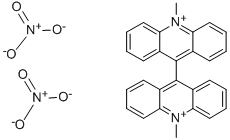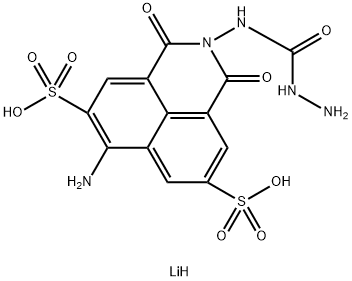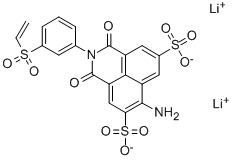N,N′-Dimethyl-9,9′-biacridinium dinitrate , Chemical emitting reagent grade , 2315-97-1
Synonym(s):
9,9′-Bis(N-methylacridinium nitrate);Lucigenin
CAS NO.:2315-97-1
Empirical Formula: C28H22N4O6
Molecular Weight: 510.5
MDL number: MFCD00011925
EINECS: 219-023-4
| Pack Size | Price | Stock | Quantity |
| 250MG | RMB287.20 | In Stock |
|
| 1G | RMB799.20 | In Stock |
|
| 5g | RMB2799.20 | In Stock |
|
| others | Enquire |
PRODUCT Properties
| Melting point: | 250°C |
| storage temp. | room temp |
| solubility | acetic acid: soluble10mg/mL |
| form | powder |
| color | Yellow powder with orange to brown cast |
| λmax | 455nm |
| BRN | 3901768 |
| Biological Applications | Chloride indicator; diagnosis of hemostatic disorders; detecting bacteria,nucleicacids,proteins,pathogens; identifying respiratory infections; generating and detecting reactive oxygen species; chemiluminescent indicator |
| InChI | InChI=1S/C28H22N2.2NO3/c1-29-23-15-7-3-11-19(23)27(20-12-4-8-16-24(20)29)28-21-13-5-9-17-25(21)30(2)26-18-10-6-14-22(26)28;2*2-1(3)4/h3-18H,1-2H3;;/q+2;2*-1 |
| InChIKey | KNJDBYZZKAZQNG-UHFFFAOYSA-N |
| SMILES | C1(=C2C=CC=CC2=[N+](C)C2=CC=CC=C12)C1=C2C=CC=CC2=[N+](C)C2=CC=CC=C12.[N+]([O-])([O-])=O.[N+]([O-])([O-])=O |
Description and Uses
Lucigenin is a chemiluminescent probe used to detect superoxide production and the presence of chloride. It can be used to detect superoxide production by enzymatic and cellular sources. It is a sensitive method that has been applied to the monitoring of superoxide production from xanthine oxidase, microsomal NADPH cytochrome reductase, and NADPH oxidases of phagocytes, endothelial cells, fibroblasts, and smooth muscle cells of blood vessel walls. However, it produces similar chemiluminescence signals in isolated aortic and cardiac tissues from wild-type and Nox1-Nox2-Nox4 triple knockout mice, suggesting that it is not selective for NADPH-based ROS production. It also reacts with hydrogen peroxide without generating free radical intermediates and has been used to detect lipid hydroperoxide in oils. Lucigenin is also used as a fluorescent chloride-sensitive indicator, with its fluorescence being quenched by chloride (ex/em = 455/505 nm, respectively). Lucigenin fluorescence is insensitive to phosphate, sulfate, and nitrate.
Chemiluminescent probe for the detection of peroxides in biological systems.
Safety
| Symbol(GHS) |   GHS03,GHS07 |
| Signal word | Warning |
| Hazard statements | H272-H315-H319 |
| Precautionary statements | P210-P220-P221-P264-P280-P302+P352+P332+P313+P362+P364-P305+P351+P338+P337+P313-P501 |
| Safety Statements | 24/25 |
| RIDADR | 1479 |
| WGK Germany | 3 |
| HazardClass | 5.1 |
| PackingGroup | III |
| HS Code | 29339900 |


![FCLA Free Acid [Chemiluminescence Reagent]](https://img.chemicalbook.com/CAS/GIF/133118-06-6.gif)



